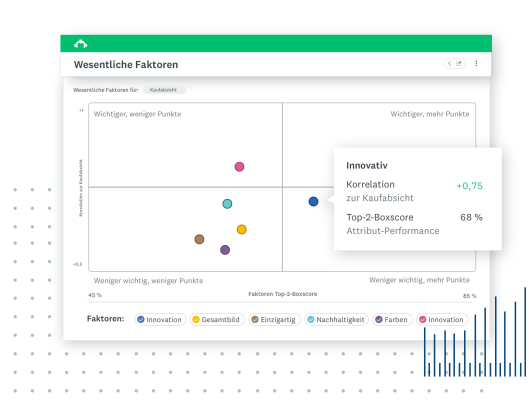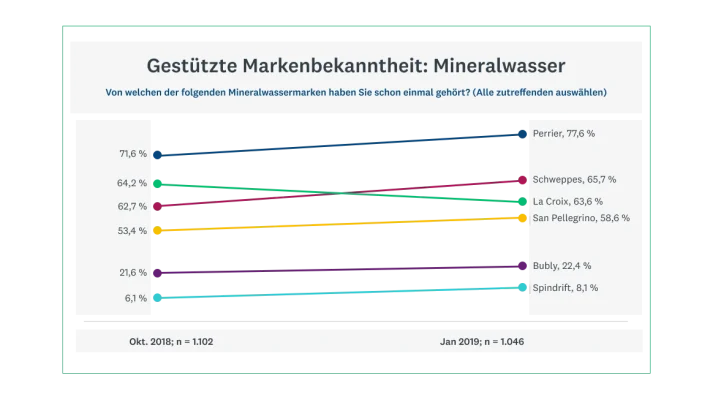More Resources
Was ist eine Usage-and-Attitude-Studie?
Eine Studie zu Nutzung und Verhalten (Usage and Attitude, U&A, oder Attitude and Usage, A&U) ist eine beliebte auf Erhebungen basierende Studie. Sie wird in der Marktforschung eingesetzt, um ein tieferes Verständnis Ihres Marktes zu erzielen, um herauszufinden, wer was, wo und wie oft kauft und um die Beziehung zwischen Meinungen/Einstellungen und Konsumgewohnheiten zu untersuchen. Mit einer solchen Studie können Sie Antworten auf häufige Fragen finden, wie zum Beispiel:
- Wofür genau wird mein Produkt oder meine Marke verwendet?
- Nutzen verschiedene Kundentypen mein Produkt oder meine Marke auf unterschiedliche Weise?
- Gibt es unterschiedliche typische Verwendungsmuster für mein Produkt?
- Nutzen bestimmte Verbrauchersegmente mein Produkt mehr oder weniger häufig?
- Verwenden die Kundinnen und Kunden nur mein Produkt oder auch Produkte der Konkurrenz, und wenn ja, welche?
Es gibt vier Haupttypen von U&A-Studien, die zur Beantwortung dieser Fragen verwendet werden können. Welchen Ansatz Sie genau verwenden, hängt von Ihren Bedürfnissen ab. Sie können einen oder eine Kombination aus einigen der folgenden Ansätze wählen:
- Ein Ansatz zum Verständnis der Kategorie: Das Ziel dieser Art von Usage-and-Attitude-Studie ist es, mehr über die Merkmale des Marktes als Ganzes zu erfahren. Wenn Sie beispielsweise Bekleidung online verkaufen, möchten Sie vielleicht mehr über die Merkmale der typischen Online-Fashion-Käufer:innen erfahren, wann sie einkaufen, wie oft und wie (z. B. über Handy, Tablet oder Laptop).
- Ein Ansatz zur Marktgrößenbestimmung: Diese Art der U&A-Forschung konzentriert sich auf das Verständnis der Marktdurchdringung verschiedener Produktkategorien sowie auf die Nutzungs- oder Konsumhäufigkeit. Selbst wenn Sie in Ihrem Online-Shop eine breite Palette von Kleidungsstücken verkaufen, kann es beispielsweise sein, dass Online-Käufer:innen bestimmte Produktkategorien (wie Unterwäsche) lieber in einem Ladengeschäft vor Ort kaufen, wo sie die Artikel anprobieren oder ein besseres Gefühl dafür bekommen können, wie sich der Stoff anfühlt. Dieses Wissen kann Ihnen bei allen möglichen Marketingentscheidungen helfen, etwa bei der Frage, was Sie auf Lager halten und was Sie bei welcher Zielgruppe bewerben sollten.
- Ein Ansatz zum Markenverständnis: Sie können Usage-and-Attitude-Studien einsetzen, um Erkenntnisse über Markendurchdringung, Markenwahrnehmung, Markenwert sowie Einflussfaktoren auf die Markenwahl zu gewinnen: ganz entscheidend für die Entwicklung Ihrer Wettbewerbsstrategie.
- Ein Ansatz zum Targeting: Aus einer Usage-and-Attitude-Studie lassen sich auch wichtige Informationen ableiten, die zur Unterstützung der Kundensegmentierung basierend auf Einstellungen und Verhaltensweisen verwendet werden können, was Ihnen bei Ihren Targeting- und Messaging-Maßnahmen hilft.
Wie gut kennen Sie Ihren Zielmarkt?
Ermitteln Sie die Motivationen und Bedürfnisse Ihrer Nutzer:innen mit unserer Lösung Nutzung und Verhalten.
Wann sollte eine U&A-Studie durchgeführt werden?
Einer der Hauptvorteile einer Usage-and-Attitude-Studie ist, dass sie so vielseitig ist und sich für unterschiedlichste Einsatzzwecke anbietet. Insbesondere sollten Sie die Durchführung einer Studie zu Nutzung und Verhalten in Betracht ziehen, wenn Sie eines der folgenden Bedürfnisse haben:
- Sie möchten die Wünsche und Probleme der Kundinnen und Kunden besser verstehen
- Sie glauben, dass Ihnen möglicherweise Gelegenheiten zur Steigerung von Konsum oder Nutzung entgehen
- Sie stehen kurz davor, neue Produktkategorien oder Marketingstrategien zu entwickeln
- Sie möchten ein besseres Verständnis für die breitere Wettbewerbslandschaft entwickeln
Ziele einer Usage-and-Attitude-Studie
Erkennen der neuesten Trends im Käuferverhalten, die die Marktdynamik in Ihrer Branche bestimmen
Die Käufer:innen ändern ständig ihre Einstellung zu Produkten und Services, was sich entsprechend auf das Kaufverhalten auswirkt. Ihre sich verändernden Einstellungen und Verhaltensweisen werden nicht nur dadurch beeinflusst, wie Sie mit ihnen interagieren (z. B. durch Ihre Marketingkampagnen), sondern auch durch die Aktionen Ihrer Mitbewerbenden und durch allgemeine Veränderungen im Marktumfeld. Die Corona-Pandemie ist ein gutes Beispiel: Die Hersteller von alkoholischen Getränken stellten fest, dass nicht nur der Verkauf von Wein und Spirituosen für den Genuss zu Hause zunahm, sondern dass auch die durchschnittlichen Verbraucherausgaben stiegen. Wenn sich das Verbraucherverhalten derart ändert oder die Branche von einer Art Schock oder Disruption heimgesucht wird, ist es an der Zeit, eine Bestandsaufnahme von Nutzung und Verhalten der Konsument:innen vorzunehmen, um die nächsten Schritte besser planen zu können.
Gewinnung eines tieferen Kundenverständnisses, um die Akzeptanz und den Kauf Ihrer Produkte oder Services zu steigern
Sobald die Kundinnen und Kunden Ihr Produkt mit nach Hause nehmen, ist der Verkauf abgeschlossen, oder? Nun, ganz so einfach ist es nicht.
Manchmal konzentrieren wir uns auf die Angebotsseite des Geschäfts, die Verkaufssteigerung, und vergessen dabei, wie unsere Produkte in das tägliche Leben unserer Kund:innen passen, sobald sie das Geschäft verlassen. Ein tiefergehendes Verständnis der Nutzung durch die Menschen kann jedoch dazu beitragen, dass Ihr Produkt Ihrem Kundenkreis optimal gefällt und es zusätzliche Bedürfnisse erfüllt, was wiederum den künftigen Umsatz steigern kann. Nehmen wir zum Beispiel an, Ihr Hauptprodukt ist ein Crosstrainer für zu Hause. Nehmen Sie sich die Zeit, etwas über die Interaktionen Ihrer Kund:innen mit dem Gerät zu erfahren, z. B. in welchem Raum sie es stehen haben, wie oft sie damit trainieren und wie die Familienmitglieder es abwechselnd benutzen, dann können Sie fundierte Erkenntnisse gewinnen. Diese wiederum können Sie in die künftige Produktentwicklung einfließen lassen und Ihre Marketingkampagnen dadurch besser ausrichten. Sie könnten etwa feststellen, dass jüngere Familienmitglieder das Gerät nutzen wollen, dessen Größe aber nicht kindgerecht ist, was die Entwicklung von Trainingsgeräten speziell für Kinder nach sich ziehen könnte.
Quantifizierung der Nachfrage nach Ihren Produkten, um Ihre Angebote in jedem Schritt des Entwicklungsprozesses zu verfeinern: Ideenfindung, Entwicklung, Markteinführung und Iteration
Ein weiteres Ziel von Usage-and-Attitude-Studien ist die Evaluierung der Verbrauchernachfrage nach Ihren Produkten bei einer bestimmten Zielgruppe. Das hilft Ihnen, Ihre Positionierung und Ihr Produktangebot zu optimieren, und versetzt Sie in die bestmögliche Lage, um den Absatz anzukurbeln. Stellen Sie sich zum Beispiel vor, Sie verkaufen Yogamatten und möchten Ihren Markt vergrößern, um Einsteiger zu erreichen. Auf der Grundlage der Ergebnisse einer U&A-Studie, die die Gesamtnachfrage nach Yoga sowie den Ort, an dem Yogamatten verwendet werden (z. B. zu Hause oder im Studio), und die Art der ausgeführten Übungen untersucht, könnten Sie eine bedruckte Matte entwickeln, die Einsteigern zeigt, wo sie ihre Füße bei bestimmten, beliebten Stellungen platzieren müssen. Mit anderen Worten, Sie kreieren ein innovatives Produkt, das die Bedürfnisse Ihrer Kundschaft besser erfüllt und das Interesse an Ihrer Marke fördert.

Nutzung als Grundlage für künftige Strategien
Wenn Sie sich auf eine bedeutende Veränderung vorbereiten, etwa die Einführung einer neuen Produktreihe, die Investition in eine große Werbekampagne, die Erweiterung der Marke oder den Eintritt in einen neuen Markt, ist eine Usage-and-Attitude-Studie absolut unerlässlich. Es ist unmöglich, sich sicher zu sein, dass der Schritt erfolgreich sein wird, wenn Sie nicht über ein tiefes, aktuelles Wissen über Ihren Kundenstamm, das Nutzungsverhalten und die Einstellung Ihrer Kund:innen gegenüber Ihrer Marke und anderen Unternehmen verfügen. Mittels einer U&A-Studie können Sie sich Klarheit über diese Fragen verschaffen, was Ihnen bei der Gestaltung und Optimierung Ihrer Strategien helfen wird.
Die Durchführung einer Usage-and-Attitude-Studie kann Ihnen dabei helfen, durch eine optimierte Marken- und Produktstrategie Möglichkeiten zur Erweiterung und zum Ausbau Ihres Unternehmens zu erkennen. Sehen wir uns einmal an, wie Sie eine solche Studie durchführen können.
Methodik bei Usage-and-Attitude-Studien
Es gibt verschiedene Möglichkeiten, eine Studie zu Nutzung und Verhalten durchzuführen. Eine der effektivsten Methoden folgt jedoch dem traditionellen Modell des Verkaufstrichters, das damit beginnt, ein breiteres Verständnis Ihres Marktes zu erlangen, und sich dann auf die spezifische Art und Weise konzentriert, wie die Menschen mit Ihrer Marke interagieren oder sie wahrnehmen. Sehen wir uns die einzelnen Schritte an.
Schritt 1: Ziehen Sie die richtige Stichprobe heran
Obwohl die Daten aus U&A-Studien sehr nützlich sein können, scheitern viele Unternehmen dabei an der ersten Hürde. Sie versäumen es, eine geeignete Stichprobe heranzuziehen. Es ist entscheidend, dass die Stichprobe, aus der Sie Ihre Daten erheben, wirklich repräsentativ für Ihren Kundenstamm ist. Ist Ihre Stichprobe beispielsweise auf eine ältere Zielgruppe ausgerichtet, die lieber im Geschäft statt im Internet einkauft, dann wird Ihre Bewertung von Nutzung und Verhalten Ihres Marktes wahrscheinlich nicht stichhaltig sein. Stattdessen müssen Sie Ihre Zielgruppe sorgfältig kalibrieren, damit sie Ihren tatsächlichen Kundenkreis in Bezug auf Demografie, Psychografie und Verhalten widerspiegelt. Wenn Sie sich nicht sicher sind, wie Sie eine solche Stichprobe finden können, haben wir eine vordefinierte Zielgruppe für Sie, die Sie nach Kriterien wie Geschlecht, Einkommen oder Beschäftigung auswählen können.

Allgemeinbevölkerung (mittlere Stichprobe)
- Alle Geschlechter (Erhebung)
- Alle Altersgruppen (vollständige Erhebung)
- Alle Einkommen
- 500 Beantwortungen, Deutschland - SurveyMonkey

Vollzeitbeschäftigte
- Alle Geschlechter (Erhebung)
- Alle Altersgruppen (einfache Erhebung)
- Alle Einkommen
- Vollzeitbeschäftigt
- 250 Beantwortungen, Deutschland - SurveyMonkey

Konsument:innen
- Alle Geschlechter (Erhebung)
- Alle Altersgruppen (einfache Erhebung)
- Alle Einkommen
- Hauptentscheider:in im Haushalt
- 250 Beantwortungen, Deutschland - SurveyMonkey
Schritt 2: Nutzen Sie die unaufgeforderten Markenerinnerung, um eine Basislinie festzulegen
So wie eine Usage-and-Attitude-Studie häufig dazu dient, eine Ausgangsbasis für künftige Marketingentscheidungen zu erhalten, kann der erste Teil einer Befragung zu Nutzung und Verhalten Ihnen dabei helfen, einen Bezugspunkt für weitere Untersuchungen festzulegen. Bitten Sie die Befragten, die Marken oder Produkte zu nennen, die ihnen in einer bestimmten Kategorie sofort einfallen, dann erhalten Sie eine solide Vorstellung von der Bekanntheit Ihrer Marke im Vergleich zu der der Konkurrenz sowie von der Wirksamkeit Ihrer jüngsten Marketingkampagnen.
Schritt 3: Bewerten Sie die Nutzung bestimmter Marken und die Einstellung zu spezifischen Marken
Nutzen Sie als Nächstes eine Umfrage, um die Einstellung der Kund:innen zu bestimmten Produkten oder Marken und deren Nutzung zu untersuchen. Der aufgeforderte Markenerinnerung ist eine hervorragende Möglichkeit dafür. Sie könnten zum Beispiel eine Reihe von konkurrierenden Marken auflisten und die Befragten dann bitten, anzugeben, welche sie kennen, welche sie derzeit nutzen und bei welchen sie die Nutzung in Erwägung ziehen.

Schritt 4: Sehen Sie sich die Details an
Nachdem Sie nach der Bekanntheit und Nutzung Ihrer Marke gefragt haben, sollten Sie die Wahrnehmung Ihrer Marke durch die Kund:innen und vielleicht sogar die Ihrer Mitbewerbenden etwas genauer untersuchen. Stellen Sie sich beispielsweise vor, Sie haben einen Online-Shop für hochwertige Bekleidung eröffnet. Nehmen die Kundinnen und Kunden Ihre Marke wirklich als Premiummarke wahr, oder gibt es konkurrierende Shops, die als noch prestigeträchtiger angesehen werden? Fragen Sie nach der Wahrnehmung Ihrer Positionierung, dann können Sie ein Gefühl dafür bekommen, wie Ihre Marke auf dem bestehenden Markt platziert ist und wie stark sie sich im Wettbewerb verhält.
Fragen im Hinblick auf Nutzung und Verhalten
Probleme, Bedürfnisse und Wünsche
Unabhängig davon, ob Sie ein bestehendes Produkt oder einen Service auf einem bekannten Markt verkaufen oder ein neues Produktangebot entwickeln, ist es von entscheidender Bedeutung, dass Sie ein Profil Ihrer Zielkundschaft im Kopf haben. Die Durchführung einer U&A-Erhebung zur Erfassung von Bedürfnissen, Wünschen und Problemen der Verbraucher:innen wird Ihnen helfen, auf einer fundierteren Grundlage zu verstehen, wer Ihre Kundinnen und Kunden sind, was sie wollen und warum. Sie können entweder geschlossene oder offene Fragen verwenden, um diese Art von Erkenntnissen zu gewinnen. Entscheiden Sie sich für offene Fragen, so könnten Sie etwa folgendes fragen:
- Was ist das Frustrierendste am Online-Einkauf von Kleidung?
- Was hält Sie davon ab, Kleidung online zu kaufen?
Oder Sie könnten geschlossene Fragen stellen wie:
- Hätten Sie ein unbegrenztes Budget zur Verfügung, würden Sie online oder offline mehr für Kleidung ausgeben? [online/offline]
- Wenn Sie Kleidung online kaufen, welcher der folgenden Faktoren ist für Sie am wichtigsten? [der Preis/die Passform/die Qualität/die ethischen Grundsätze/die Marke]
Stellen Sie die Fragen, die Sie schon immer stellen wollten
Erhalten Sie durch die Lösung Nutzung & Verhalten von SurveyMonkey ein tiefgreifendes Verständnis für die Wünsche Ihrer Zielgruppe.
Einstellungen und Nutzung im Hinblick auf Ihre Marke oder Ihr Produkt
Wie der Name schon vermuten lässt, sollten die Fragen in einer U&A-Erhebung so gestaltet sein, dass Sie mehr über die Nutzung und das Verhalten der Konsumentinnen und Konsumenten entlang der Customer Journey (Kundenreise) erfahren. Das bedeutet, dass das Hauptaugenmerk auf der Wahrnehmung der Produkte liegt, wie die Menschen über Ihre Angebote denken und wie sie Ihre Produkte im Alltag nutzen. Denken Sie zum Beispiel an eine so einfache Frage wie:
- Wie häufig kaufen Sie online neue Kleidung ein?
Schon die Antworten auf diese Frage können Ihnen dabei helfen, Ihren Markt basierend auf dem Konsumverhalten zu segmentieren. Sie könnten feststellen, dass Sie drei Zielgruppen haben: einmal diejenigen, die selten online einkaufen, dann diejenigen, die niemals online einkaufen, und diejenigen, die täglich online einkaufen. Die Analyse der Antworten in Verbindung mit den Antworten auf die Fragen nach den Erfahrungen der Verbraucher:innen im Hinblick auf den Online-Einkauf oder ihre Einstellungen zum Online-Einkauf ganz allgemein liefert Ihnen umfassende Erkenntnisse. Diese können dann dazu beitragen, dass Sie die spezifischen Bedürfnisse der einzelnen Segmente besser erfüllen, dass Sie neue Produkte oder Services auf die richtigen Zielsegmente ausrichten und dass Ihre Kund:innen bei jedem Einkauf aufs Neue zufrieden sind.
Einstellungen gegenüber Ihren Mitbewerbenden
Bei einer Usage-and-Attitude-Studie geht es nicht nur darum, die Einstellungen der Verbraucher:innen gegenüber Ihrer eigenen Marke und Ihren Produktkategorien zu ermitteln. Vergleichsfragen können wichtige Erkenntnisse über Ihre Positionierung im Vergleich zu Ihren Mitbewerbenden geben. Sie können den Befragten beispielsweise eine Liste mit Konkurrenzprodukten und -marken vorlegen und sie bitten, diese in eine Rangfolge zu bringen, vom beliebtesten Produkt bis zum am wenigsten beliebten. Alternativ können Sie auch spezifische Fragen zu den relativen Eigenschaften verschiedener Produkte in einer einzigen Kategorie stellen, etwa:
- Welche der folgenden Marken hat Ihrer Meinung nach die beste Qualität?
- Welche der folgenden Marken ist Ihrer Meinung nach die zuverlässigste?
- Welche der folgenden Marken ist Ihrer Meinung nach die ethischste?
Kaufverhalten
Fragen, die das Kaufverhalten erfassen, sind entscheidend für die Entwicklung geeigneter Werbe-, Platzierungs- und Vertriebsstrategien, von denen wir wissen, dass sie den Absatz fördern. Zu den Fragen, die hier nützlich sind, gehören:
- Fragen über die Art der Geschäfte, die Ihre Befragten besuchen
- Fragen zu den Auslösern, die zum Kauf geführt haben
- Fragen zu Kaufhindernissen, die es möglicherweise gibt
- Fragen zur Loyalität gegenüber Ihnen und Ihrer Konkurrenz
Tipps zum Erstellen einer Usage-and-Attitude-Studie
U&A-Studien sind äußerst nützlich, da sie den Unternehmen ein grundlegendes Verständnis ihres Marktes und ihrer Kundschaft vermitteln. Eine schlecht gestaltete Erhebung zu Nutzung und Verhalten kann die Verwertbarkeit der Ergebnisse jedoch untergraben. Berücksichtigen Sie die folgenden Tipps, damit Ihre U&A-Umfrage Ihnen umsetzbare Erkenntnisse liefert:
- Legen Sie ein Ziel für die Befragung fest: Sie sollten eine klare Vorstellung davon haben, wie die Daten nach ihrer Erfassung verwendet werden sollen.
- Erstellen Sie eine interaktive, ansprechende Umfrage: Manchmal fällt es den Befragten schwer, sich zu erinnern oder zu beschreiben, wie sie Produkte in ihrem Alltag verwenden. Verwenden Sie detaillierte Medien wie Bilder von Ihrem Produkt oder ein Video von Ihrem Service, um die Idee zum Leben zu erwecken und gültige, nützliche Antworten anzuregen.
- Versuchen Sie nicht, zu viel hineinzupacken: Lange, langweilige Erhebungen, in denen alles auf einmal abgefragt wird, bringen selten die gewünschten Ergebnisse. Sollten Sie Probleme haben, Ihre Umfrage auf die wirklich wichtigen Fragen zu beschränken, können Ihnen unsere Fachleute jederzeit helfen.
Zusammenfassend lässt sich sagen, dass Sie mit einer Usage-and-Attitude-Studie ein Verständnis für die Attraktivität Ihrer Produkte und Services für Ihre Kund:innen entwickeln und künftige Marktchancen ermitteln können, indem Sie das Kauf-, Wahrnehmungs- und Nutzungsverhalten Ihres Kundenkreises untersuchen. Sind Sie bereit, loszulegen?
Beginnen Sie jetzt mit Ihrer Marktforschung
Globales Umfragepanel
Erfassen Sie Marktforschungsdaten, indem Sie Ihre Umfrage an eine repräsentative Stichprobengruppe senden.
Marktforschungs-Services
Lassen Sie sich bei Ihrem Marktforschungsprojekt helfen, indem Sie mit unserem Expertenteam zusammenarbeiten.
Expertenlösungen
Testen Sie Werbe- oder Produktkonzepte mithilfe eines automatischen Analyse- und Reporting-Ansatzes.
